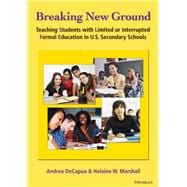
| Introduction | p. 1 |
| Culture, Literacy, and Learning | p. 11 |
| What Is Culture? | p. 11 |
| Individualism versus Collectivism | p. 13 |
| Collectivistic Cultures | p. 14 |
| Individualistic Cultures | p. 14 |
| A Continuum-Not a Dichotomy | p. 15 |
| How Does Culture Influence Learning? | p. 17 |
| Formal Education | p. 17 |
| Pragmatic and Academic Ways of Thinking | p. 18 |
| Assumptions and Culturally Based Pedagogy | p. 20 |
| Literacy | p. 22 |
| What Is Literacy? | p. 23 |
| SLIFE Achievement Gap or Cultural Dissonance? | p. 25 |
| For Further Exploration | p. 26 |
| Two Different Learning Paradigms | p. 27 |
| Conceptualizing a Learning Paradigm | p. 28 |
| Conditions for Learning in the Two Settings | p. 29 |
| Processes for Learning in the Two Settings | p. 33 |
| Activities for Learning in the Two Settings | p. 37 |
| Two Contrasting Learning Paradigms | p. 40 |
| For Further Exploration | p. 41 |
| An Introduction to MALP: The Mutually Adaptive Learning Paradigm | p. 43 |
| Addressing Cultural Dissonance | p. 43 |
| Establish and Maintain Communication | p. 45 |
| Identify Priorities | p. 47 |
| Build Associations | p. 48 |
| The Mutually Adaptive Learning Paradigm | p. 48 |
| Teachers Accept Students' Conditions for Learning | p. 50 |
| Students and Teachers Combine Processes for Learning from Both Paradigms | p. 53 |
| Students Learn New Classroom Activities | p. 54 |
| For Further Exploration | p. 57 |
| Infusing Lessons with MALP | p. 59 |
| Lesson Planning and Academic Task Objectives | p. 59 |
| Social Studies Scenario | p. 61 |
| Discussion of Christina's Lessons | p. 64 |
| Using the MALP Checklist | p. 67 |
| Math Scenario | p. 67 |
| Discussion of Rick's Lessons | p. 71 |
| For Further Exploration | p. 78 |
| Project-Based Learning | p. 84 |
| What Is Project-Based Learning? | p. 84 |
| Oral Interaction in the Classroom | p. 86 |
| What Is a Project and What Is Not? | p. 87 |
| Project-Based Learning and MALP | p. 88 |
| Accept Conditions for Learning | p. 89 |
| Combine Processes for Learning | p. 90 |
| Focus on New Activities for Learning | p. 92 |
| Implementing Project-Based Learning | p. 93 |
| Project-Based Learning and the Curriculum | p. 95 |
| For Further Exploration | p. 97 |
| Projects Targeting Academic Thinking | p. 98 |
| Why Target Academic Thinking? | p. 99 |
| Mapping Time | p. 100 |
| Timelines | p. 101 |
| Collections | p. 103 |
| The Mystery Bag | p. 103 |
| Autobiography | p. 105 |
| Transitions | p. 106 |
| Bookmarking | p. 108 |
| Delicious.com | p. 109 |
| For Further Exploration | p. 113 |
| Sample Project-Class Surveys | p. 114 |
| Why Class Surveys? | p. 114 |
| Introducing the Concept of Surveys | p. 116 |
| Select the Topic | p. 117 |
| Create and Organize the Questions | p. 119 |
| Conduct the Survey | p. 124 |
| Analyze and Quantify the Results | p. 125 |
| Draw Conclusions | p. 126 |
| Report on the Survey | p. 127 |
| Disseminate the Results | p. 128 |
| After the Survey-Following Up | p. 128 |
| For Further Exploration | p. 129 |
| Reflecting on MALP | p. 130 |
| Ms. Kempinski Makes the Journey | p. 130 |
| Revisiting Cultural Dissonance | p. 133 |
| Vuong Makes the Journey | p. 135 |
| Education Is Just the Beginning … | p. 135 |
| For Further Exploration | p. 137 |
| References | p. 139 |
| Index | p. 149 |
| Table of Contents provided by Ingram. All Rights Reserved. |
The New copy of this book will include any supplemental materials advertised. Please check the title of the book to determine if it should include any access cards, study guides, lab manuals, CDs, etc.
The Used, Rental and eBook copies of this book are not guaranteed to include any supplemental materials. Typically, only the book itself is included. This is true even if the title states it includes any access cards, study guides, lab manuals, CDs, etc.